Financial education is IMPORTANT! I hope I don’t have to explain you that…look at the graph of Prof. Geert Van Campenhout (KU Leuven) which shows 55% financial literacy in Belgium. I believe this percentage is even lower if you would take into account the knowledge on how to grow your money. 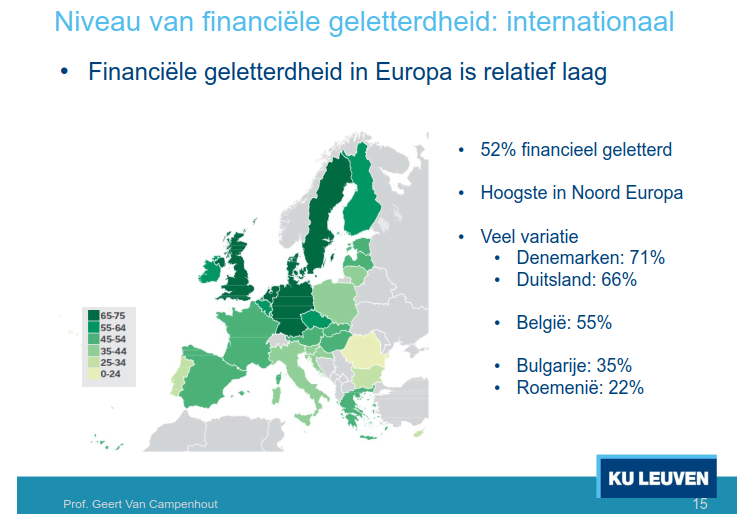
If you read my biography in About me, you know that we invest time each year in our financial education and how to grow our money by investing in the stock market. This also means sacrificing a Saturday or an evening instead of being with the family. One of those activities to learn about stock investing is to attend conferences organized by VFB, the Flemish federation of investors. URL www.vfb.be
On the 24th of February, the VFB organized a Technical Analysis (TA) day where different speakers came to speak about different TA methodologies, strategies or software. This is the THIRD time I attend this event.
You can download the presentations here in the appendix. Below you can find our notes and comments for the presentations we attended.
Section 1 : Presentation Notes
The day was opened by a warm welcome of Patrick VERELST, chairman of VFB. He was delighted to see more attendees to this conference.
Below you can read the summary notes of the presentations we attended. We add Our Comments at the end of each session.
General session: Macro-economic Forecast
Speaker: Danny Reweghs, Director Strategy Inside Beleggen.
Danny started with saying that the year 2017 was a turning point for the economic growth. 45 countries in the world had an economic growth. Severe doubts about economic growth are fully banned. Everywhere there is modest to strong growth. This applies to US, Europe, Japan and emerging countries.
In the US, there has been the tax cut. Trump tries to implement his program he promised. Strong tax cut for companies and big infrastructure investments are key points of his program. These investments and tax cuts need to keep the economy growing.
But the debt deficit of the US keeps on growing….The timing of all those stimuli can be questioned. Will this result in sufficient positive consequences for the US budget? This is a threatening problem for the next recession. The problems can be bigger for the long-term horizon.
Europe picks up the growth phase with a ‘strong’ economic recovery in 2017. We can hope for a 2% or more growth in 2018. 2% is very important and a minimum requirement to pay the increasing social security and pension payments costs.
Will the weak dollar be a trouble maker? Here are 4 possible threats for the economic growth.
T1. Too strong euro. US uses the policy ‘ our currency, your problem’. A weak dollar benefits the US exports and trade.
T2. Elections in Italy. Threat for new populism politics. Italy is one of the financial weak countries. What will the results be?
T3. Troubles after ending the QE by the central bank ECB. A first interest rate in Europe is possible in the coming months. What will the impact be on the market?
T4. Brexit negotiations who end completely wrong.
Japan is out of intensive care. Japan has suffered long time from chronic recession and deflation. The duo Abe-Kuroda execute a positive turnaround. The inflation % although is not yet sufficient. The central bank of Japan keeps on adding stimuli for the economy and there’s a new dynamic within the Japanese economy.
Emerging markets profit from all this economic growth. China shows solid growth and position of Xi Jinping is stronger than before. Brazil and Russia show also recovery thanks to recovery of commodities prices. Emerging markets profit from all this world economic growth. Possibly we have reached the top tipping point here.
The forecast for the 2018 stock market is a more volatile year. It is too soon to be pessimistic. We got a first warning during past weeks in February. The chances for a strong market correction increase as the year progresses. A possible higher top before the summer is possible. So the advice is to be more active.
The golden tip is to invest in GOLD. Sectors that have been lagging behind are financials and oil companies. The Belgian biotech has been discovered by investors as an opportunity, Go more into CASH before the summer or end of the year.
Our comments:
The presentation of Danny Reweghs did not contain any surprises for me from a macro economic perspective. It is true that the Belgian Biotech is hot today in the stock market. Can Galapagos go higher? Mithra just doubled in stock price value. ..Which ones have still potential?
I don’t see a big bullish market for financials and oil companies. Some banks are vulnerable today and the liquidity and bad loans will kick in hard when interest rates go higher. The cheap new money in the market will dry out. So we will see what the impact will be. Some will collapse. Markets will have to correct themselves to normal supply and demand of money. Some banks are lagging behind in digital technology and need to transform their business models. The same occurs in the oil sector. The OPEC together with RUSSIA and some other oil producing countries have reduced the supply while US kept on increasing the shale production.
For me interesting oil companies are diversified energy companies such as Total, Shell and BP that have started to operate in different energy sectors. They also pay a solid sustainable dividend.
Unknown in Investors’ world : The successful marriage between gaps and options
Speaker: Jacky DE DONDER, hoofdredacteur BeursBubbels
Jacky De Donder is Beursbubbels and author of the book “Timing is money”. Jacky reads his foreward of his book to start his own introduction. Jacky is more a fundamental investor and adds technical analysis (TA) to measure the subjective value of a stock price and its valuation price growth. The key is to have a trade plan !
Jacky is not a fan of Technical Analysis but he uses TA for buy signals and portfolio management. Most importantly for the candle sticks and gaps in combination with the option tables activity. The presentation theme is how to use gaps in combination with options.
Jacky prefers to write options. Jacky shows a parallel with cycling to explain the meaning of a gap. Jacky is a long term investor and not a trader. Most gaps will be closed during the day. He is not interested in those intraday gaps. What interests Jacky? When the gap is strong…a range break out gap. This results in a trend channel turnaround after being in a channel for months or years. This means a NEW trend of the stock !
You can find gaps on www.nasdaq.com with the unusual volume. You can also find them also on After Hours Most Active and Pre-market Most active. Mostly earnings are the reason for the gap. We don’t know if the gap will be sustainable. Here are a few strategies.
Strategy 1 : Gaps and bought call options (bullish)
With candle sticks you can see what investors think about a stock. Paypal for example is an interesting company as it operates in an interesting sector. It sits in an innovative part of this sector. On 5th December 7000 contracts at a strike of 72,5 appeared. On the graph, you can see a closing of the gap. 70 appears to be the resistance. Big option orders are entered in the market. A new rally is taking off.
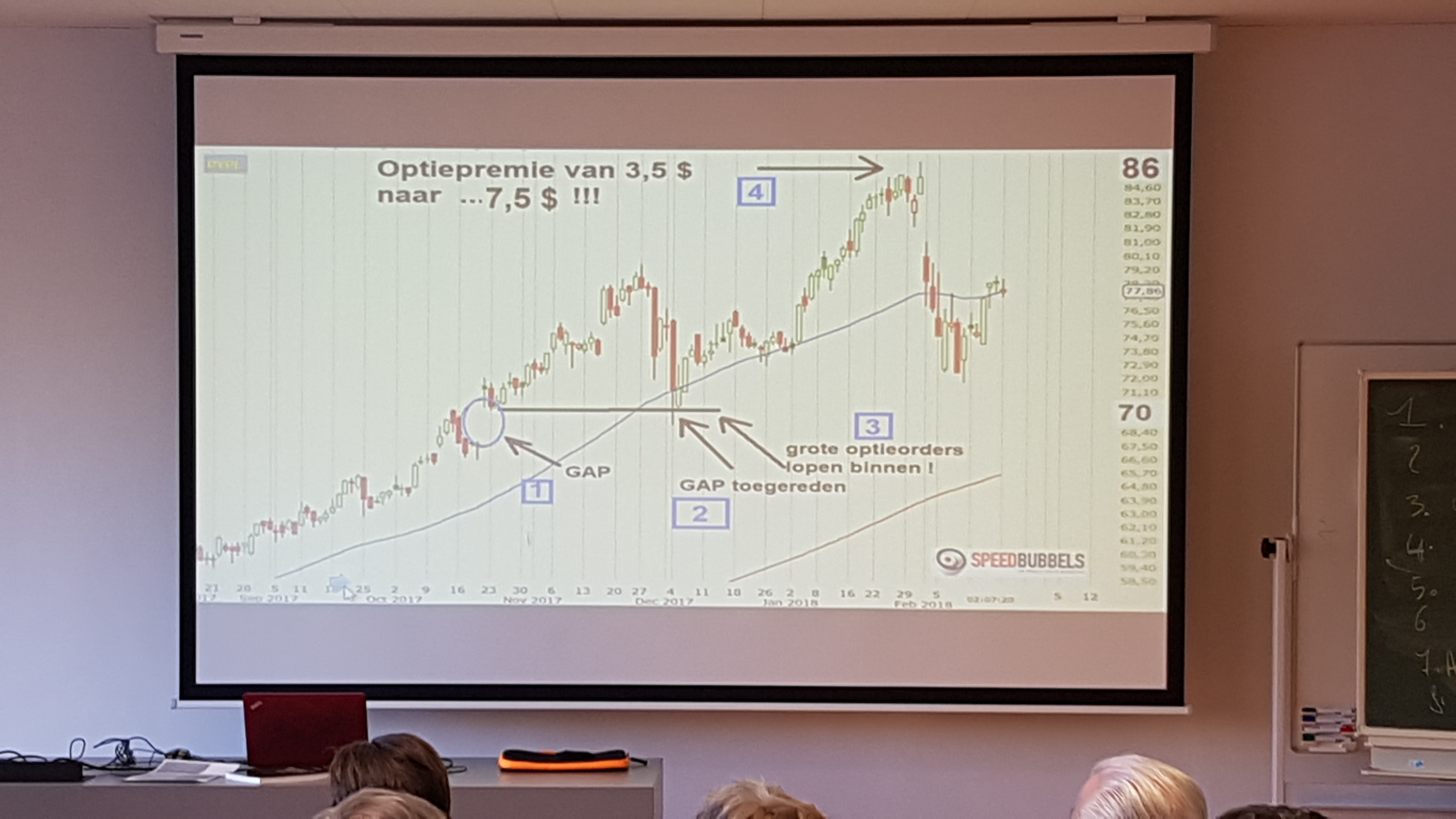 Example 2. Trip advisor. 11k contracts at strike of 35. Gap down with a bounce up. Big addition of contracts resulting in a closure of the gap.
Example 2. Trip advisor. 11k contracts at strike of 35. Gap down with a bounce up. Big addition of contracts resulting in a closure of the gap.
Example 3. Spark Therapeutics. 12 Dec. 2017. At strike 55 4640 contracts are purchased. Expiry June 2018. OTM call options purchase. Look at the gap…stock is at 42$. So purchaser wants to buy 25% higher than the current stock market price. Very speculative…why does he do this before June?
On 19 Dec. FDA approves medicine Luxturna 1 month before 12th January 2018. The investor anticipated the reversal and news. The stock price goes to 62$ and to the moon.
Example 4. Palo Alto networks. 13 May 2017. A big cyberattack in the world. So momentum for security protection companies. 2400 contracts at Strike 200 with a leap contract. OTM options are AIR. This investor wants to buy at 200$ while the stock price is 120$. Here is also a gap. While the stock price may break out and close the gap, this investor takes a long term risk on the opportunity to close the gap. What do you see next ? The gap is slowly closed.
Strategy 2. Gaps and purchased puts.
Here you have the shares and add insurance with a put or you don’t have the shares and go short.
Example 1. Go Pro. 12k contracts at 10$. ITM put means that this investor wants to have an insurance and hedge his share position. This is a fund manager who hedges his share position. Today stock is 5,5$.
Strategy 3. Gaps and written put options
Put options are alternative for buying stocks at lower price.
Example 1. Analog devices. This sector is hot. Somebody writes 35k puts at 0,57 for 15 days. On the graph you clearly see a pivot at 82$. This line was not broken
Jacky manages 2 portfolios.
- Investing with 4 stocks. Strategy : turnaround companies achieving a nice average. Write 2/3 ATM calls.
1000 shares. 700 call writing and buy puts.
Example. Zynga. Doing 3 years nothing.. Signal that turnaround is occuring.. Adapt the strategy from covered calls to new resistance level. Only write for 50% covered calls.
Example 2 : Twitter
New gaps for Twitter. Turn around is getting stronger. April earnings will be important. If a new gap occurs, then Twitter will go to 50 – 60$ (IPO level)
Portfolio 2 is more speculative for the subscribers of Beursbubbels.
Our comments:
As we get familiar more and more with options investing strategies, this presentation was very interesting as Jacky showed the strategies he applies for the subscribers of his newsletter. He uses options in combination with gaps. He identifies the positions that big investors take with options and follows the strategy of following the SMART MONEY. His gains are coming from benefiting the range break outs or closing the gaps. I will request some sample newsletters to understand the content of this newsletter. (www.beursbubbels.be)
Then we will learn about those strategies and see if we can paper trade them first. I am always interested in learning ‘how to fish’.
Winners have a plan. Losers have an excuse
Speaker: Paul GINS, CEO CompuGraphics
Paul Gins starts with the strategy ingredients that he covered in his 2017 presentation. Why would you use Technical Analysis? Are you pro or contra Technical Analysis?
The person who doesn’t used TA is missing something BIG. On the website www.transfolio.eu you can find already a lot of information.
You can also invest manually. What are the advantages ?
- Better feeling for market
- Possible better results. What will be your benchmark – Robot ?
- What do robot or manual trading have in common?
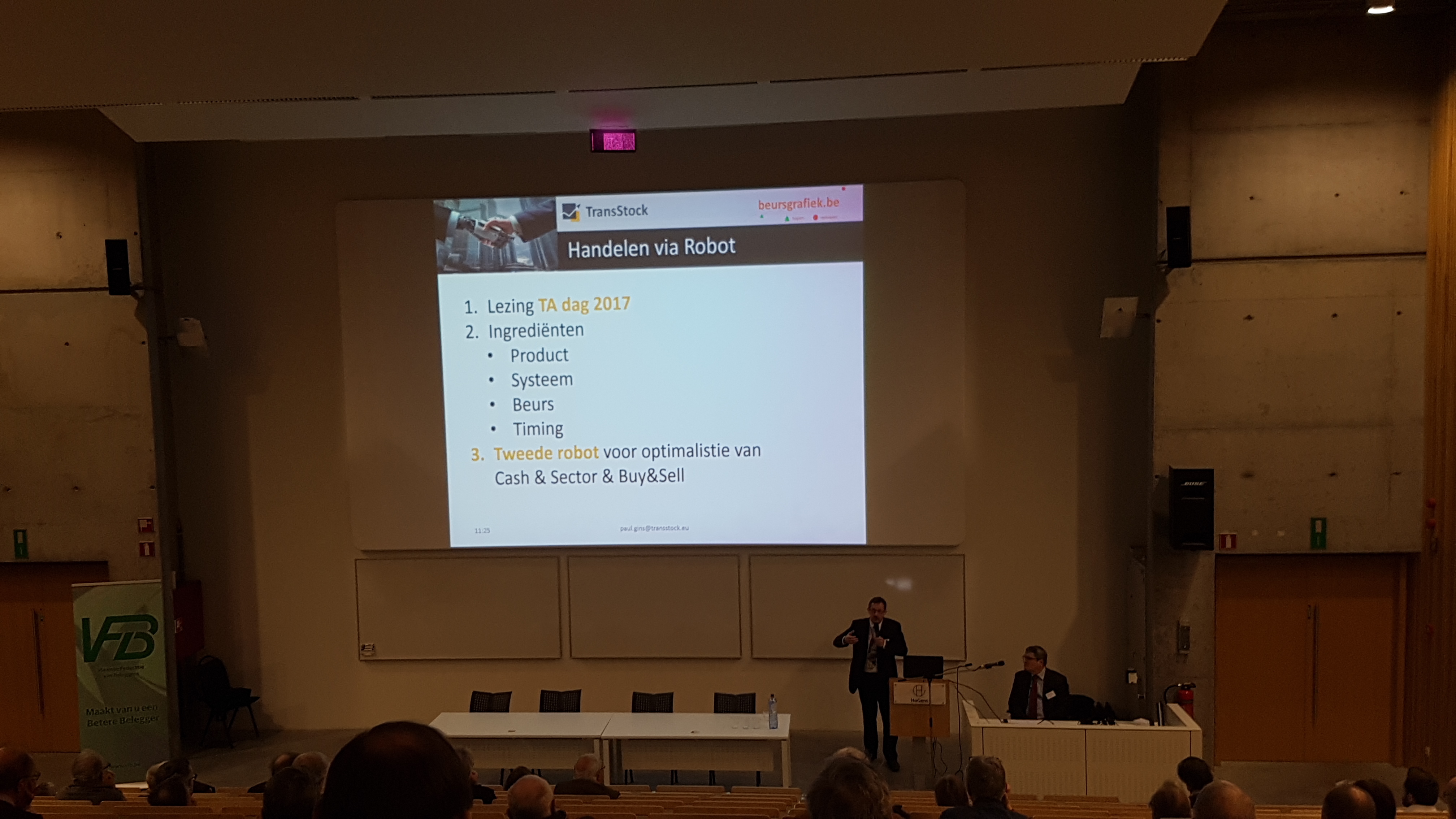 Both need a trade or investment plan ! Without plan, emotions are taking over..
Both need a trade or investment plan ! Without plan, emotions are taking over..
You can use TA indicators to help out in the methodology for finding strong stocks in a strong index.
Example. Anheuser Inbev
Key questions to be asked are…
- What does Inbev within the sector?
- What does the sector where Inbev operates in?
- What does Belgian index versus other indexes?
- Which shares are outperforming?
Which Stock Market > Sector > Stocks > Yes/No is the right approach.
There are many TA indicators.
What are the ingredients of a good TA plan?
- Strong trend move
- Upward move
- Trend start
- Range or break out of the stock
Strength of the move is measured by Welles Wilder directional movement indicator (ADX) of candle sticks. Second indicator is MACD from Gerald Appel. Third indicator is CCI from Donald Lambert. Each indicator has his own function and you need to use them together.
New Highs are also important within stock analysis. Does this stock make new highs? Can this upward trend be continued? ADX set on 10, MACD 12,26 and CCI
Before buying, you need to decide on your stop loss level. Then when a stock market occurs, you can step out.
Winners always have a PLAN, losers have an EXCUSE !
Our comments:
Paul presented his 2017 presentation and made it easy. He added 3 technical indicators to his last year presentation. As CEO of the software Transstock (which I also use), he has a methodology to find the strong stocks in a strong market. If you can find the winners in the right trend, you can only win if you execute with a trade plan. Investing is simple if you follow the trend ! The trend is YOUR FRIEND !
In the past 7 years bullish market, investing in the stock market was simple if you picked the winners and strong companies. Just take a look at the FANG stocks : Facebook, Apple, Netflix, Google.
Don’t be surprised by next stock market crash
Speaker: Geert VAN HERCK, Chief Strategist Keytrade Bank
Geert starts with an overview of the stock markets. The MSCI All Countries World Index still shows a strong upwards trend. The index has been strongly overbought. A corrective phase has begun and will continue coming months. Have we seen the top? We are in the final bull rally. We start a volatile stock market year. The MSCI Emerging markets look different. The emerging markets are at very attractive valuations. Emerging markets offer a very good long term opportunity.
EURO STOXX 50 can not break out of his important resistance level. Support is just above 3000 points. Europe Stoxx 600 shows a triple top from 2000, 2007 and 2011. Downwards potential is present. We have to look first at Wallstreet and when Wallstreet drops, all indexes will take a hit.
Nikkei 225 shows an outbreak of the bear market. RSI indicator is used to find negative and positive divergence between the index and the RSI indicator. But the upward trend can be at the last legs.
The Euphoriameter shows a combination of the VIX, Forward PE and Bullish Sentiment. Very positive sentiment with very low VIX means you have to become more cautious. You need to have a plan to step out of the market. The Investors Intelligence Sentiment shows much more bullish sentiment compared to bears. Geert believes we are in a final phase of the bull market. 2018 will be a challenging year.
Let’s take a look at CAPE ratios. CAPE + PE value is very important for the future return. Buy cheap valued stock markets, avoid too expensive markets. (source : www.starcapital.de) Invest more in emerging markets and cheaper valued indexes. Look for cheap countries, sectors, companies.
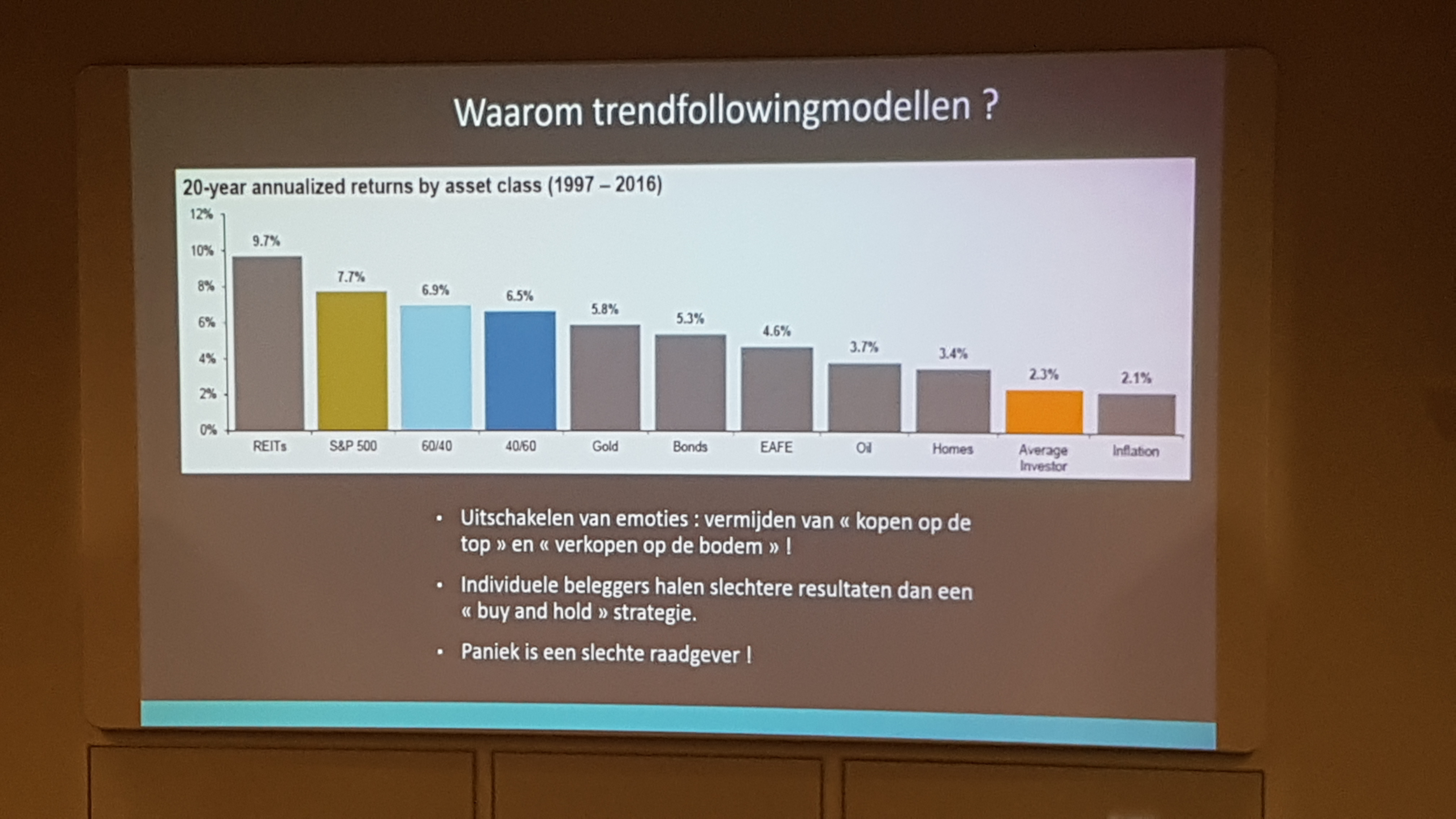
So how can you eliminate emotions within investing? Use Trendfollowingmodels. Average investors achieve worse results than buy and hold investor. Investing in REIT resulted in 9,7% over 20y annualized return. Look at news and media. For example the Short bet from Ray Dalio against big companies..how do you interpret this information and use it ? The most important words in Investing are “ I don’t know”
So you need a plan. Value investing works. But also trend investing and momentum investing works. Two examples. Faber metholodogy. 10 month SMA rule. Buy rule when monthly price > 10 SMA.
Antonacci methodology is another way. Dual momentum investing. Sources are www.dualmomentum.net, www.optimalmomentum.com. This methodology compares the momentum to Treasury-Bill (RF) momentum. The two methodologies are combined in a Downside Protection Model. You assess the trend following rules for the asset class. You can limit the losses and step out on time.
You can worldwide invest by using regional trackers. Make a top 5 of the best performing ETF trackers each month. Assess each tracker against the Downside Protection Model and compare against the MSCI World Index. Do the same for sectors in Europe. You can see here that there was a preference for materials, Information Technology and Industrials.
If you had invested strongly in Financials in 2007, you got a clear SELL signal on the graph.
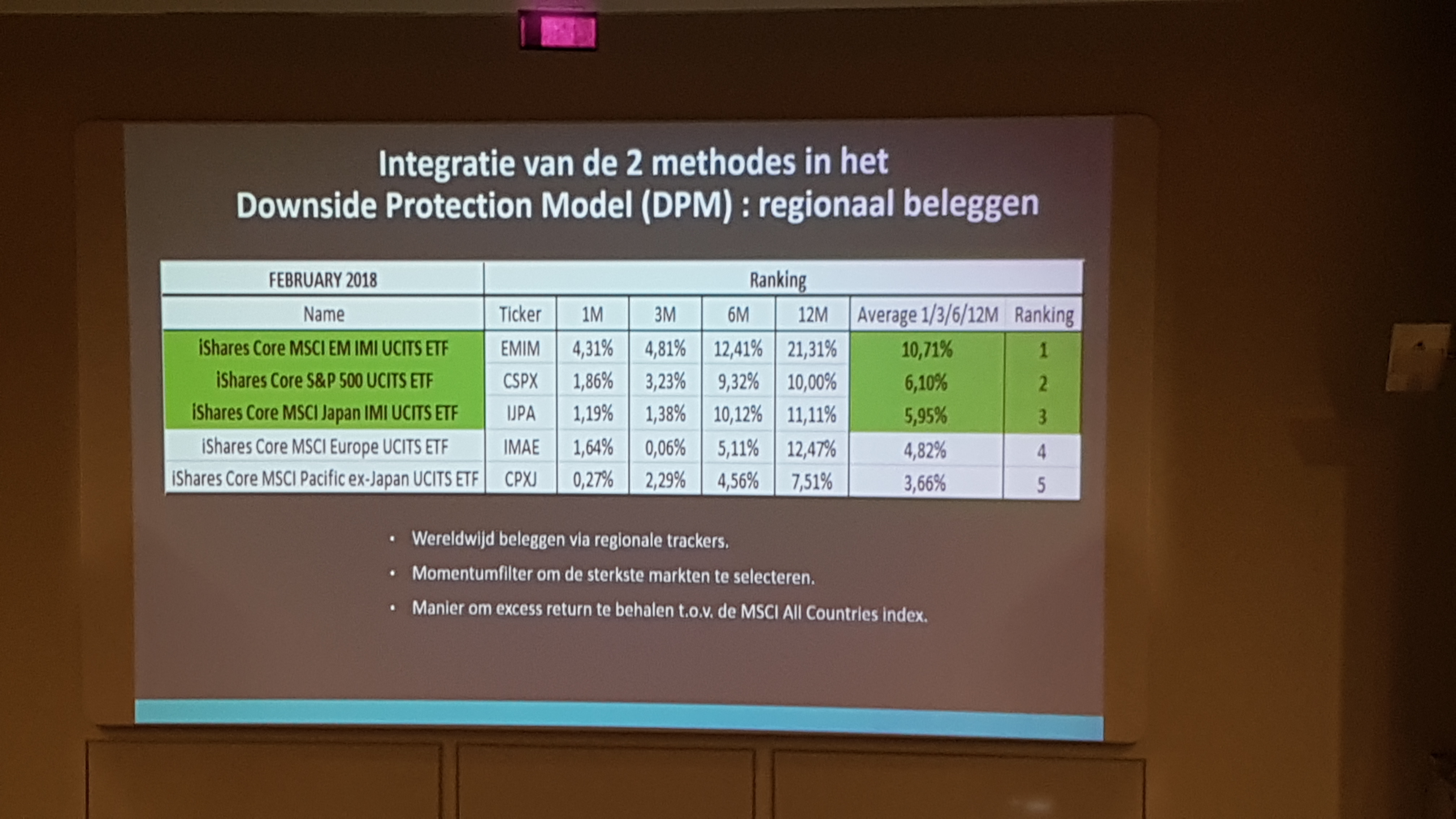
Geert is happy with a return of 7-10% per year basis and warns to be cautious in current markets. Invest in ermerging markets for the long horizon.
A simple model : Eight trackers and then invest in the top 3 each month. Be disciplined and keep it simple! And eliminate your emotions!
Our comments:
Last year Geert presented 80% of the same presentation. Only his general outlook and conclusions were different. The investing strategy is based on ranking ETFs based on the combination of the method Faber with the method Dual Momentum Investing from Antonacci. This allows you to enter and exit the market based on Moving averages. A safe methodology to achieve results as a private banker of Keytradebank.
What you risk, is not what you invest…
Speaker: Dirk VANDYCKE, Monest.net and Chartmill.com
Profit is coming from winners subtracted by the losers. How many losers do you have? How many winners do you have and how big are your winners? You control your winners and losers. You can never achieve 100% winners. You have to cut quickly your losers. You can put a trailing stop at a winner or you can simply add to a winner. What is the potential risk ? You don’t spread anymore…you focus only on your winners.
Risk can be countered by diversification. But Dirk argues with that statement.
Example : TESLA additions.
Dirk had at a certain moment 180% of his portfolio in TESLA i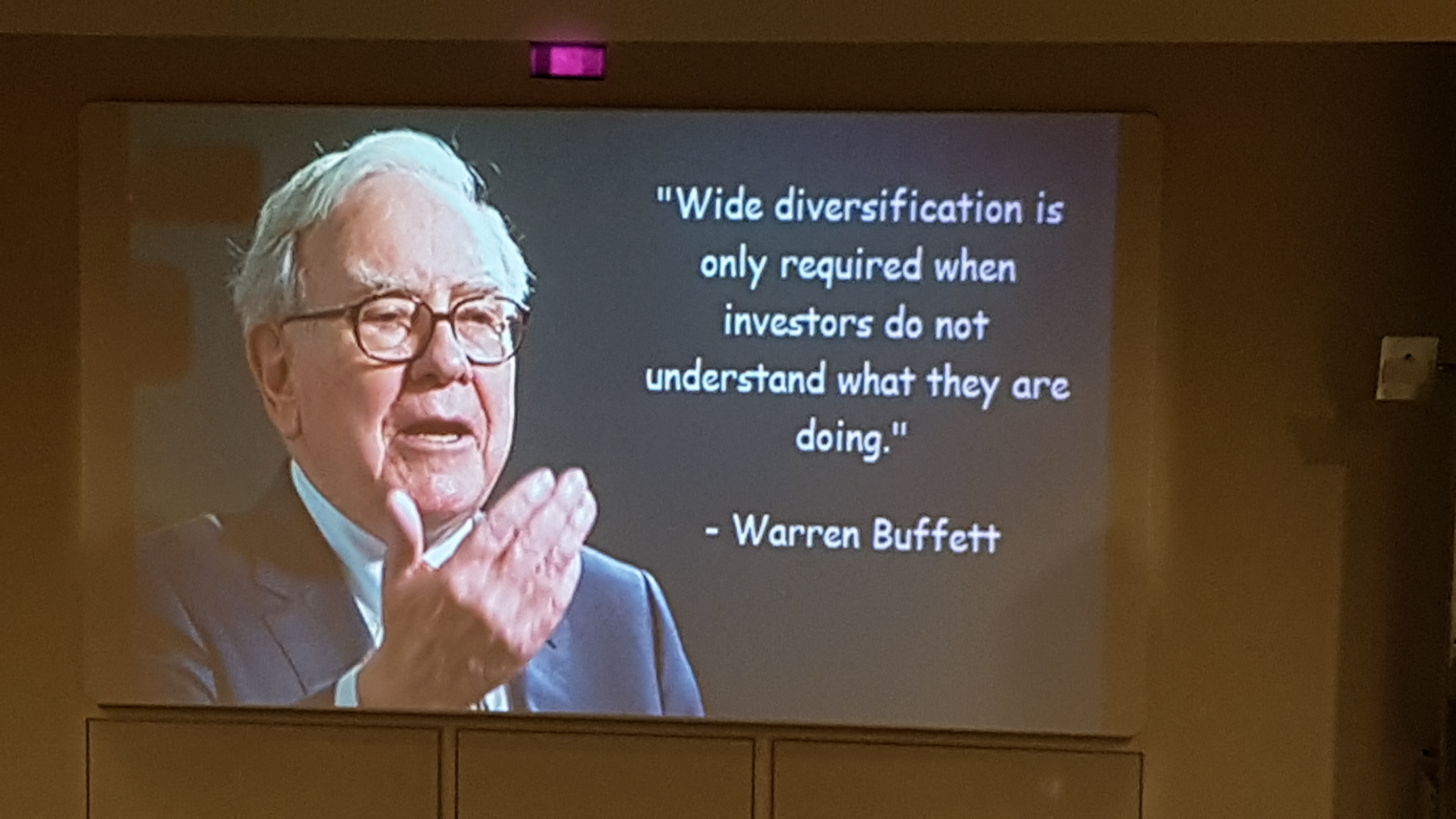 ncluding a margin account.
ncluding a margin account.
If you let a computer do a simulation with 10 positions and let them run. You do the same for another portfolio but you put stop loss under 5% drop. You use the money to add to your 9 positions. Then you compare. The black line (adding to 9 positions) achieves better performance including transaction costs.
Warren Buffett does also have a statement about diversification. Dirk starts a Case Study – Investment vs Risk
When you invest always in the same stock, what is impact on risk? You invest 1% of your portfolio. 5 shares. Risk per share 10. Investment % is not linear equal to risk %. Investment XYZ is 40,22%. Risk XYZ is 2,15%. Dirk explains Average True Range (ATR). ATR is the average move of a stock over 20 days. Dirk explains the reasoning on how to take positions and the impact on risk % and portfolio %.
Percent volatility XYZ is now 0,78 percent in the case study. Fund managers balance their portfolio based on volatility of each position. Investment has increased to 67,53% with risk 3,87 %. Adding to position increases your risk.
How can you use call options
We want to eliminate the risk in our portfolio. We use a call option close to the stock price. We sell our share position. Instead we do Investment 5,550 Options – Investment XYZ 11,94.
If XYZ hits its stop, the option will be OTM. With call options, you cannot lose your complete investment.
Our comments :
Dirk is a very passionate and great speaker and one of his credos is risk and money management. If you invest in the stock market, always understand the risk of each position that you enter in your portfolio. The case study was very structured and well explained but I wonder how many attendees in the conference understood the KEY message of this presentation. I advise you to download the presentation and do the math yourself.
Instead of buying 5000 euro shares, you can buy also the call options and lower your capital investment. Did you ever think about that option? Investing in the stock market is first of all understanding risk management.
Earn money with algorithmic trading
Speaker: Hans VAN DER HELM, algemeen directeur Quantmania
Hans starts with his own introduction. He was active as market maker, forex trader, algo trader and started Quantmania. He is also a columnist of IEX. (www.iex.nl)
A historic perspective. You can not earn money on a savingsaccount. 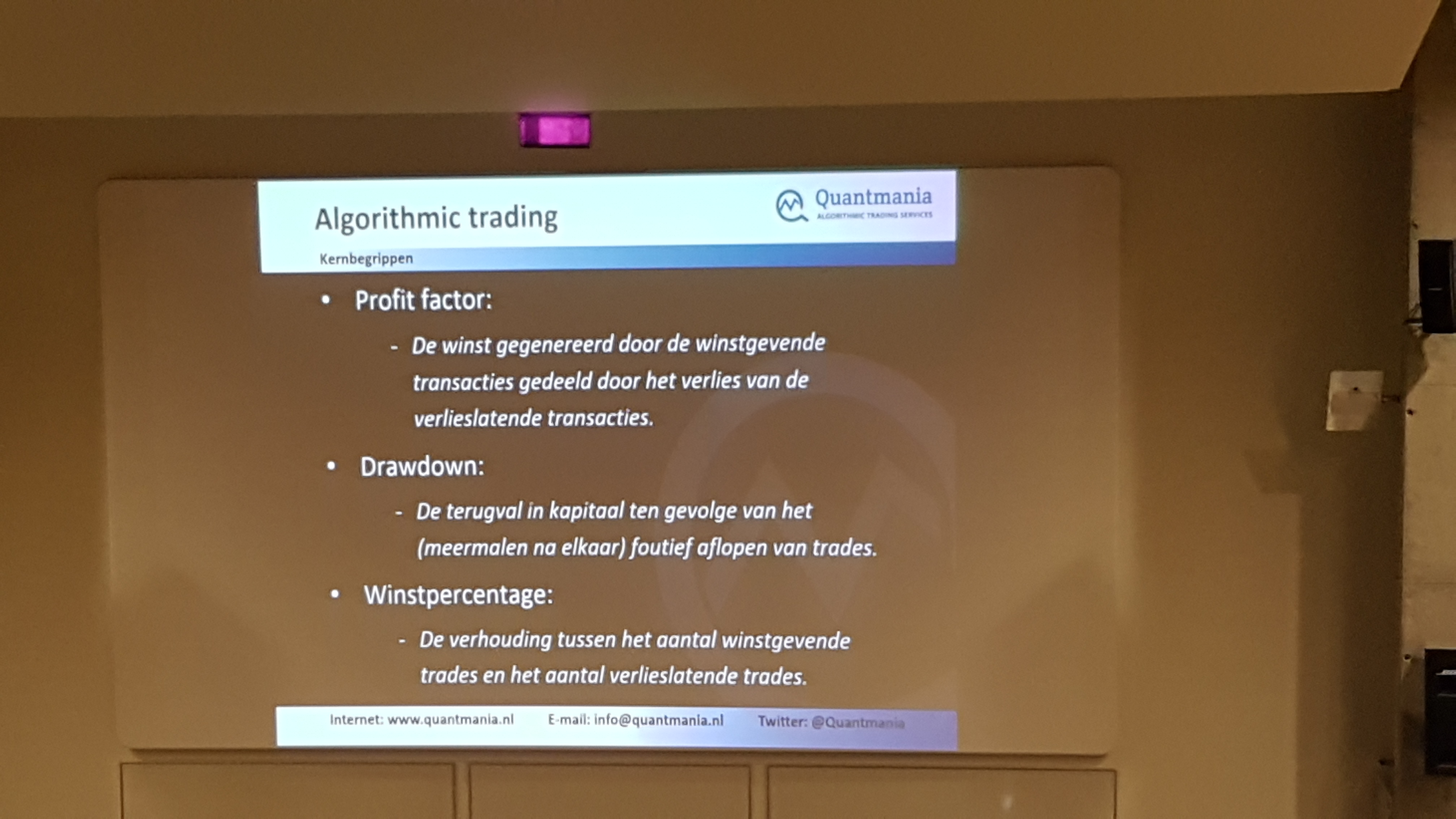 Alternatives are stock picking, If you always select the right golden stocks, keep on doing so. Another alternative is Buy and Hold. Here timing is important. Maybe you should do index investing. DAX did perform the best.
Alternatives are stock picking, If you always select the right golden stocks, keep on doing so. Another alternative is Buy and Hold. Here timing is important. Maybe you should do index investing. DAX did perform the best.
Another alternative is algorithmic trading. Emotions do not play a role. There are multiple advantages.
Hans explains what are the building blocks of Algorithmic trading. There are multiple types of strategies. He walks us through an example with DAX future. The computer decides when to buy and sell. He shows the back tested results of the different simulations. One year you had a 52% gain and another year a 30% drop. This way of investing takes emotions out of the equation and has 5x your money based on the results. But sometimes you need iron nerves when your portfolio drops 175% in value.
Hans runs a Hedgefund where you can invest in. You need a minimum investment of 100k euro but there is no guarantee.
Our comments:
Many companies exist today programming new algorithms trading the stock market. However PR news, earnings, fraud,…have an impact on the price of a stock. Can the algorithm act upon that?
Algorithmic trading exists already several years based on statistical probabilities. It’s all about math and statistics. Investing 100k in a algorithmic hedgefund is not for me. I prefer to manage my money myself, so you don’t need to blaim anybody else.
Classic and Hidden Divergence
Speaker: Wilfried Voorspoels, technisch analist VFB
Wilfriend has two parts in his presentation. Explanation of divergence (part 1) and momentum investing (part 2)
Divergence is an alert signal. Confirmation is required. Use weekly graphs to analyse the positive or negative divergence. You can also do this on monthly graphs. You can also see this in smaller timeframes of 30 minutes.
Classic divergence in upward trend (Higher highs and Higher lows) -> search for lower tops in the indicator.
Hidden divergence means :
- In upward trend – Higher Lows in the stock price but lower lows in the indicator
- In downtrend lower tops in the stock price but higher tops in the indicator
Conclusion : Hidden divergence signals continuation of the trend and is applicable for all markets (bonds – commodities and stocks)
Part 2 – Momentum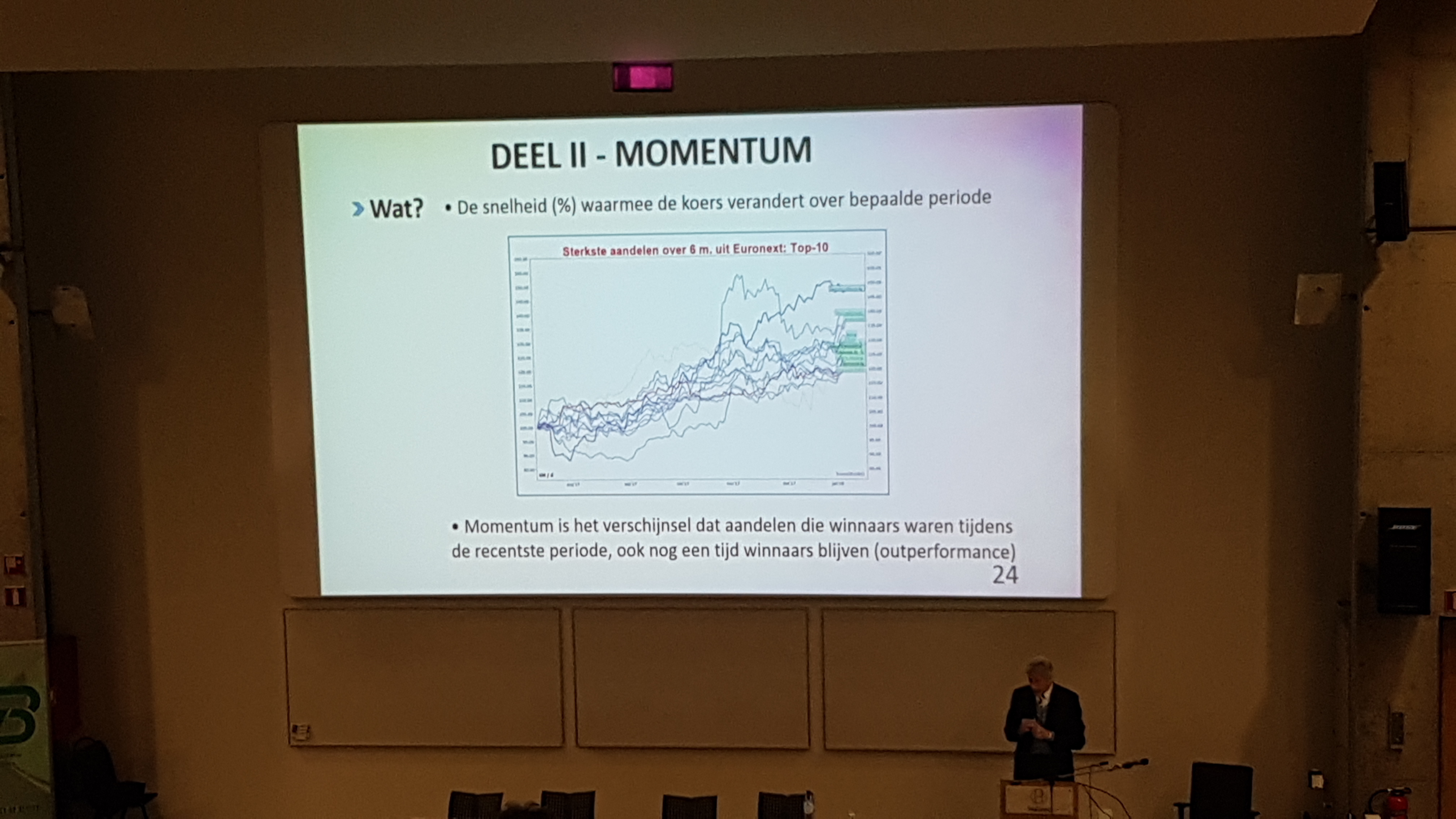
Winners from the past can remain winners in the future. Look at Relative strength of a company. Is the momentum special ? Momentum investing works.
Why do value investors hate momentum investing ? Momentum investors are cynical ‘me too’ speculative investors.
Momentum investing requires 2 things :
- Fully invested during strong bull markets
- Leave the bear markets
Find the strongest country index, sector index by using different websites such as Chartmill , Finviz or Stockcharts (limited to only 10 tickers) Or using Transstock using a scanner.
Which stocks do we want to buy ?
Wilfried recommends to use Technical analysis and trend channels to evaluate the current stock valuation. Focus on buying strong stocks. Evaluate performance after 3 months. Replace the laggers by new toppers.
Our comments:
Wilfried is one of the Belgian technical investor gurus with a very broad and deep knowledge on how to invest in the stock market. I wrote a blogpost about a book “Beleggen voor je (klein)kinderen” where Wilfried lists out different investing metholodogies based on risk. It is one of the best books I encountered listing out the different ways to invest in the stock market and knowing the risk. You can click the link above and I describe which methods I use from the book.
Inside Beleggen TOP TEN PICKS
Speaker: Marc BREMS, technical analyst Beurssignaal
Marc Brem starts with a Stock market trend analysis. In case of downwards trend look for dividend stocks with low stock value or move into cash. The strong stock market correction in February could be a signal for a trend break. The bullish trend has not yet broken.
Investors may take quicker profits. We can go sideways. The economy remains strong. The transport index, the copper price remain strong. Oil price has given a nice upward trend. Eurostoxx 50 remains underperforming. Bel0 dropped below 200 SMA.
Conclusion : Higher volatility, uncertainty. No negative turnaround. Focus is more on defensive stocks such as dividend stocks and fundamental cheap stocks.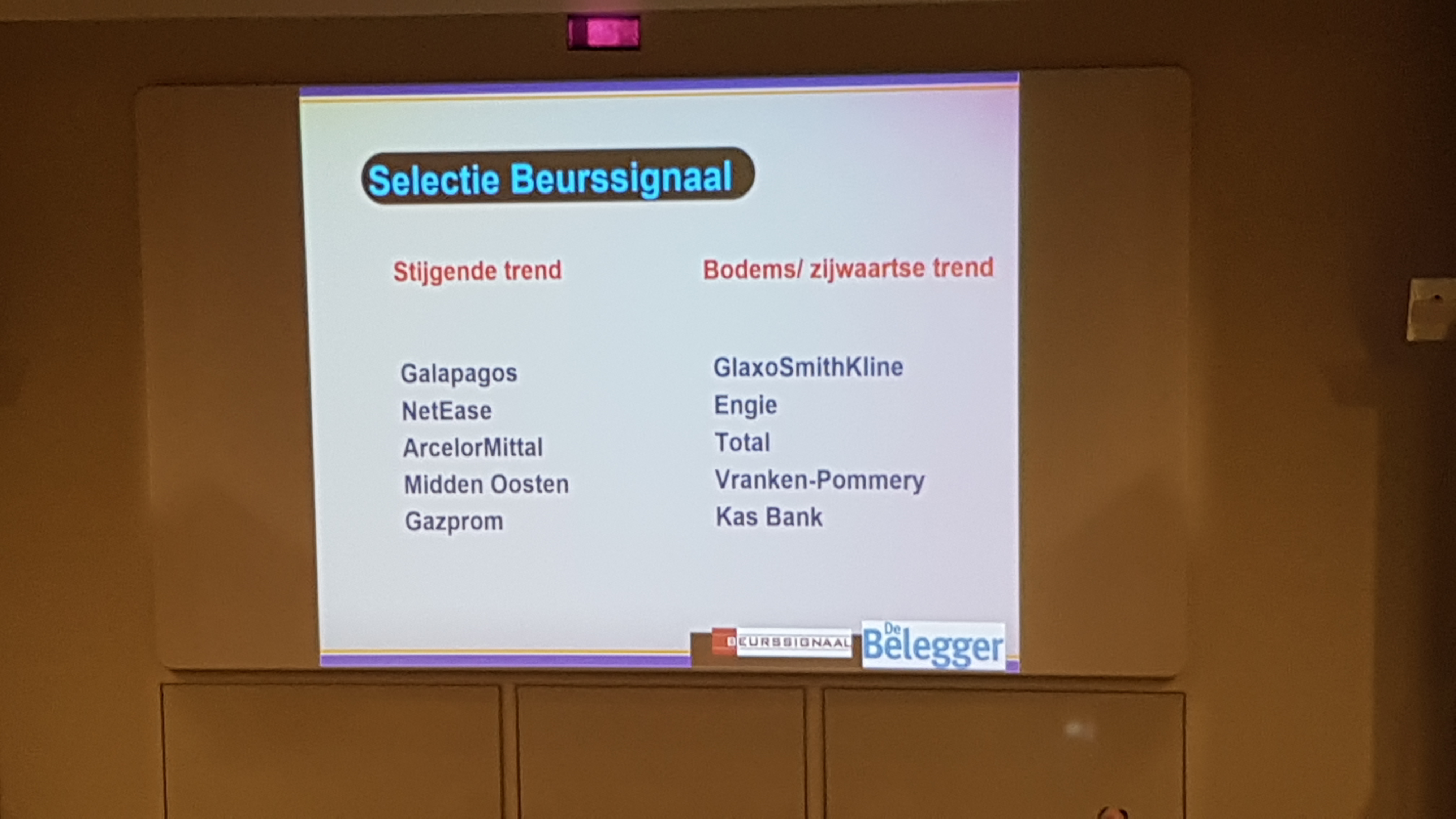
Emerging markets still have potential such as Russia and Middle East.
10 Tips :
- GlaxoSmithKline : Big pharma. Can we find a new bottom ? Low PE of 12,1. Dividend higher than 6%. If stock price remains 1280, we can buy around 1300.
- Galapagos : Hard to value. Current top forming around 90 euro. Buy at 85?
- Vranken-Pommery : smallcap going sideways. Hardly followed by analysts. PE value is higher than 30 Euro. Dividend of 3,4%. Wait for range break out around 24,5. Intrinsic value is much higher than the current stock price
- Engie : in a down wards channel. Can this stock bottom out? Energy sector has been lagging behind. Dividend of 5,4%.
- Total : Oil giant. Cheap product and diversified group. PE ratio of 12. Dividend % of 5,5%. Buy around 200SMA
- Arcelor Mittal : more speculative play. Vale is also a player within same sector.
- Kas Bank : Dutch smallcap. Dividend ratio of 6,3%
- NetEase : Chinese smaller “Tencent”. Nr in Online Games.
- Middle East : Oil price and economic reforms drive investments and economy in those markets. Aramco is a new IPO. Region will obtain a big position. Invest in tracker GULF. Or tracker KSA of Saoudi Arabia.
- Gazprom : biggest gas producer. Expansion to China. Other option is Russia tracker.
Our comments :
Last year we had a mixed opinion about the 12 stock picking tips given by the analyst Marc Brems. So we reviewed the performance of the 12 tips from last year. Vivendi, Veolia Env, Qfg, Tessenderlo and Cisco had a positive upward trend. Tracker AND, Binck, Fugro, Euronav, Carrefour, EVS turned out to lose money after 1 year buy and hold.
From this year tips, we like the dividend paying stocks such as Total and Kas Bank. We also believe in the tracker Gulf or KSA as we follow the economic developments in those countries. Gazprom, Arcelor Mittal and others are stock picks where you need to evaluate their fundamentals, the sector, the dividend,…before making an investment. Cut your losers quickly and only invest in the strong winners. So I personally prefer to stay away from stocks that are in downwards trend channel.
Key learnings and final conclusion
With more than 200 people attending the TA day, we believe this day organized by the VFB was a success! Congratulations to the organization. Each time VFB succeeds to attract speakers which bring new insights on how to invest in the stock market.
You notice a lot of grey hairs within the public. It is a pity that not more younger investors are investing time and energy to learn on how to grow their money using the stock market. We read recently that the young people invest massive in real estate and put themselves in big loans with the bank. Is that the correct choice?
We apologize for any spelling or typo mistakes but English is not my native language. We do speak 5 languages fluently tough…lol.
Keep up the good work ! See you next year. As always we end with a quote.
Appendix : The presentations
Below you can find the presentations in Dutch.
1 Macro-economische vooruitzichten; Danny Reweghs, directeur strategie MoneyTalk-Inside Beleggen.pdf (227 kb)
2 A Cryptomanie en koopkoortssignalen; Edward Loef, onafhankelijk zelfstandig technisch analist.pdf (3643 kb)
3 A Winnaars hebben een plan, verliezers een excuus; Paul Gins, zaakvoerder CompuGraphics.pdf (2954 kb)
5 A Wat je investeert, is niet wat je riskeert; Dirk Vandycke, Monest.net en Chartmill.pdf (3166 kb)
7 A Klassieke en verborgen divergenties. Winnaars blijven winnaars; Wilfried Voorspoels.pdf (5269 kb)

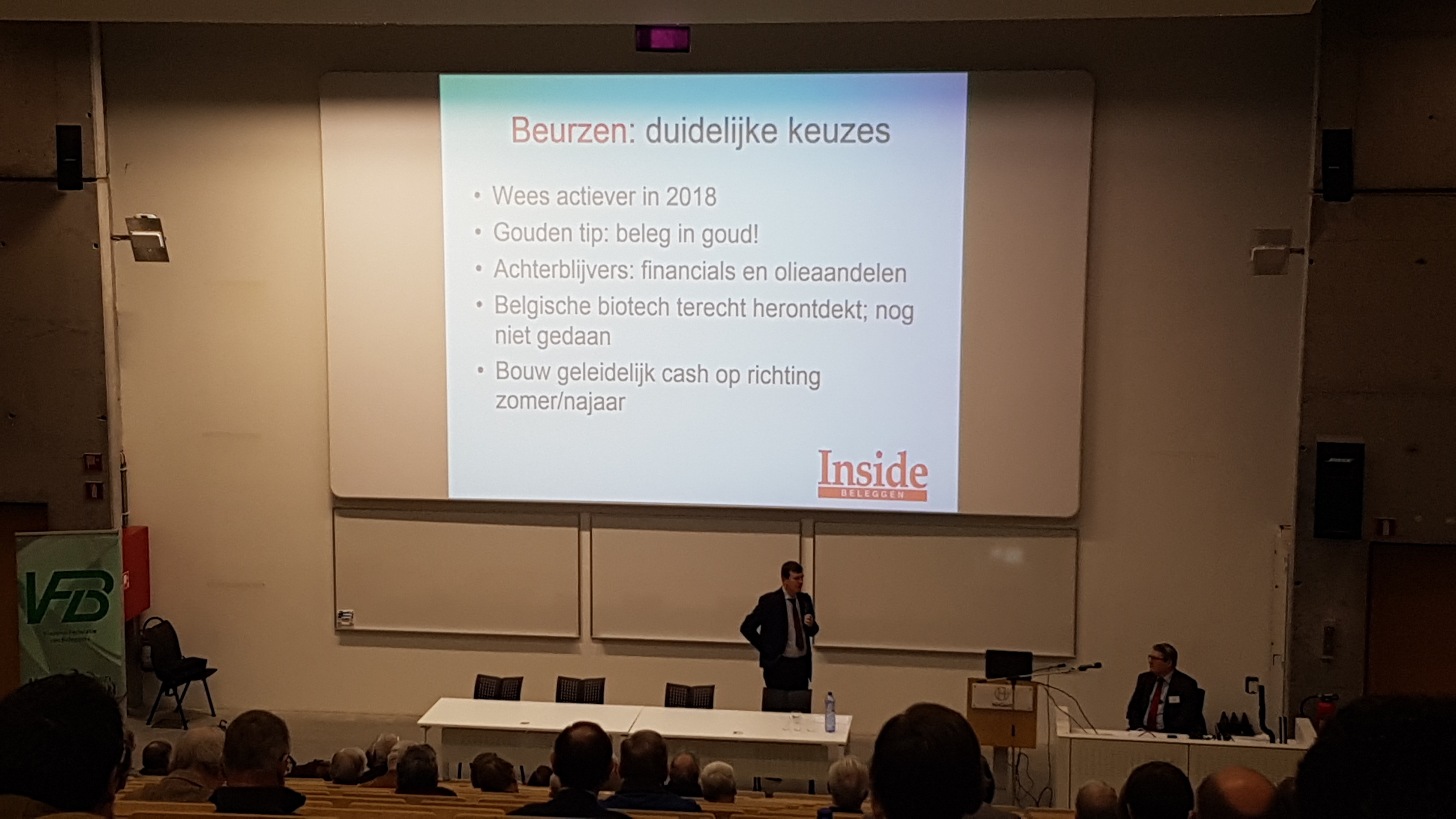
No Comment
You can post first response comment.